Nuclear Watch New Mexico, along with other watchdog groups, has announced a lawsuit against the Biden administration over its expanded production of plutonium cores for the U.S. nuclear weapons “modernization” plans. There has been inadequate environmental review by federal agencies, who have failed to detail potential impacts of the projects around communities in New Mexico and South Carolina.
The lawsuit was filed against the Energy Department and the National Nuclear Security Administration demanding the federal agency that oversees U.S. nuclear research and bombmaking must “take a legally required ‘hard look’ at impacts on local communities and possible alternatives before expanding manufacturing of the plutonium cores used to trigger nuclear weapons.”
The push from U.S. officials to “modernize” the country’s nuclear arsenal cites only general global security concerns that do not justify the science and brand new, untested technology that will be necessary to the task. citing global security concerns. Although “most of the plutonium cores currently in the stockpile date back to the 1970s and 1980s,” scientific experts estimate that plutonium pits will last 100 years or more., and on warhead type, the best estimate of minimum pit life is 85–100 years.minimum.
Los Alamos National Laboratory in northern New Mexico and the Savannah River Site near Aiken, South Carolina face enormous (and, frankly, unrealistic) deadlines to produce a massive number of plutonium cores in coming years – 50 or more cores at South Carolina and 30 or more at Los Alamos National Lab. The Savannah River Site location now has estimated costs up to $11.1 billion, with a completion date ranging from 2032 to 2035. The U.S. doesn’t need the new plutonium cores with the taxpayer bearing the burden for the expense of lagging deadlines and bloated budgets.
“The watchdog groups said Tuesday that the agency took a piecemeal approach to decide on locating the production at Los Alamos and the Savannah River Site, where nearby communities are already underrepresented and underserved.”
Tom Clements of Savannah River Site Watch said the South Carolina location was picked for political reasons following the failure of a facility designed to convert weapons-grade plutonium into commercial nuclear fuel. As the Savannah River Site has never served as a storage or production site for the pits in its history, establishing pit construction there would be “a daunting technical challenge that has not been properly reviewed,” Clements said.
With very real, current threats the U.S. is facing right now, we don’t need another Rocky Flats situation in New Mexico or South Carolina where a $7 billion, yearslong cleanup is required after the facilities fail due to leaks, fires and environmental violations, doing irreparable damage to the earth and placing communities there in unequivocal peril.






















 In her September 17, 2020 testimony before before the Senate Armed Services Committee, Lisa E. Gordon-Hagerty, Administrator of the National Nuclear Security Administration, restated the ongoing company line that more money must be spent on the US nuclear weapons stockpile, or the whole enterprise might fall over.
In her September 17, 2020 testimony before before the Senate Armed Services Committee, Lisa E. Gordon-Hagerty, Administrator of the National Nuclear Security Administration, restated the ongoing company line that more money must be spent on the US nuclear weapons stockpile, or the whole enterprise might fall over.
 Today, in the middle of the growing coronavirus pandemic, the U.S. Department of Energy ignored the real national crisis and irresponsibly shifted its focus to planning for nuclear war, revealing plans to construct a Plutonium Bomb Plant (PBP) at the Savannah River Site (SRS) in South Carolina.
Today, in the middle of the growing coronavirus pandemic, the U.S. Department of Energy ignored the real national crisis and irresponsibly shifted its focus to planning for nuclear war, revealing plans to construct a Plutonium Bomb Plant (PBP) at the Savannah River Site (SRS) in South Carolina.